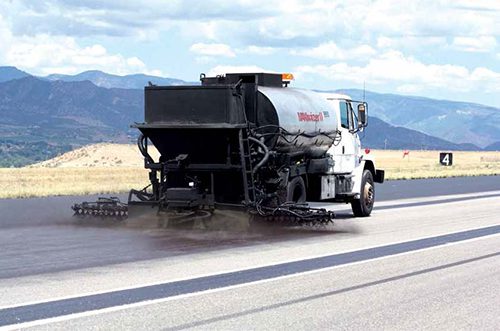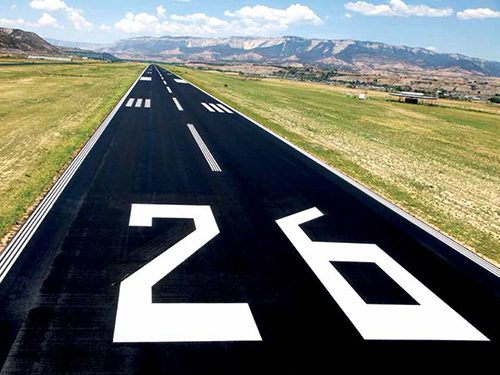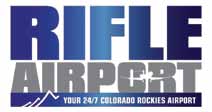 Nothing looks better from the ground or the air than a freshly surfaced runway, apron or taxiway. It's new, it's fresh and it looks professional.
Nothing looks better from the ground or the air than a freshly surfaced runway, apron or taxiway. It's new, it's fresh and it looks professional.
Then Mother Nature goes to work – with pounding rain, scorching sun, freezing temperatures and howling winds. As weather batters it daily, the pavement groans under the weight of heavy equipment and aircraft rolling over its surface. Soon, it begins to crack, moisture seeps in and the nice, beautiful runway looks like someone took a pickax to the surface.
That's a scenario Garfield County Regional Airport (RIL) in Rifle, CO, was determined to prevent after crews laid fresh, new pavement there three years ago. Instead? of waiting five years before resurfacing the new runway as most airports do, RIL devised a preventive maintenance program to postpone a full resurfacing. Data from consultants and vendors indicate that promptly spending a few hundred thousand dollars every few years could save the airport millions of dollars over the runway's total lifespan.
"We (had) an absolutely perfect runway," explains Airport Director Brian Condie. "So, one month after it was finished, we completed a 20-year maintenance plan to make sure it stayed in that same condition."
Minimizing inconvenience to airport users was also a primary consideration. Before its previous runway was torn up and replaced, RIL shut down for several days every year while maintenance workers sealed every surface crack they could find.
 Not so with the current runway. "Every year, we still go out and do maintenance checks, but we don't have to do any crack sealing. Even the longitudinal joints were still tight three years after it was poured," reports Condie.
Not so with the current runway. "Every year, we still go out and do maintenance checks, but we don't have to do any crack sealing. Even the longitudinal joints were still tight three years after it was poured," reports Condie.
On a similar vein, RIL's preventive maintenance project took four days to complete, while its last complete runway rehab lasted months.
When crews replaced RIL's pavement back in 2010, equipment ran nonstop for three days to create a single, uninterrupted section of asphalt for the runway's surface layer. "The pavers started at zero and didn't stop until they were at 7,000 feet," recalls Condie. "There are no transverse joints and no cold-cut seams on the runway. It is the first seamless runway in Colorado."
Not surprisingly, pilots love gliding to a stop on the pavement. James Edwards, chief test pilot from the avionics center at Ohio University, told Condie it is the smoothest runway on which he has ever landed. Intent on keeping it that way, Condie sought the advice of the airport's engineering team at CH2M HILL. The engineers, in turn, sought the advice of Asphalt Systems, a liquid asphalt products supplier out of Salt Lake City, to help determine the best long-term maintenance to keep the runway looking and performing like brand new.
Together, they decided to apply GSB-88, a relatively new type of sealant that Asphalt Systems describes as "well-documented" and "expanding tremendously" nationwide. When Condie and his team presented the idea to FAA officials, they immediately saw the benefit and encouraged the airport to use its annual $150,000 entitlement for the project.
"The FAA has always been pro-maintenance on runways," relates Condie.
Because the project came in around $300,000 (vs. the originally anticipated $470,000), RIL officials opted to carry over the airport's entitlement funds for a bigger project next year instead. Potential angst about not using the federal funds for runway maintenance was eliminated when state officials offered to fund 90% of the sealing project. (Garfield County picked up the remaining 10%.)
"I talked to the state aeronautical division and explained that if there was ever a way to find out if airports can save money on maintaining runways, there is no better way to test those theories than by trying it out on a brand new runway," explains Condie.
Spend Sooner, Save Later
William VanHercke, manager of aviation services for CH2M HILL's Northwest Mountain Region, is well acquainted with the challenges RIL faces as a Colorado airport. He blames ice formation during freeze/thaw cycles as the primary culprit for most early pavement failures.
"In mountainous areas subject to extreme weather conditions, asphalt will fail after only 12 years, even if a runway was initially designed to structurally hold for 20 years," notes VanHercke.
The cost of early and regular preventative maintenance saves considerable money over the long term, he stresses.
RIL, for instance, recently spent about $300,000 to apply sealant to its pavement. If it spends $300,000 every five years, it will spend $1.5 million over the runway's anticipated 25-year lifespan. If the airport does not apply sealant, VanHercke says it would likely require a full-depth resurfacing project when the runway is about 12 years old – at an estimated cost of $3 million.
"So rather than spending $1.5 million to maintain the runway over a 25-year period, the airport winds up spending $6 million on two resurfacing projects over the same timeframe," he chronicles.
A full resurfacing is also more disruptive to operations, he adds. During a major rehab, crews grind out 2 inches of material and replace it with 2 inches material, then pour a new overlay – a process that requires the runway to be out of use for one to two months. Closing two days to reseal every five years is much preferred to closing for one to two months to resurface every 12 or so years, contrasts VanHercke.
"For regional airports in communities the size of Rifle, closing its only runway is a major loss to the entire community," he notes.
Cost comparisons and closure estimates were instrumental in convincing the Colorado Department of Transportation and the FAA to fund RIL's "early" maintenance project, says VanHercke. That said, he notes that Colorado officials tend to place a greater emphasis on maintenance than those in other parts of the country.
"In an area where governments face an intense number of competing projects with limited money, officials often push maintenance out and wind up exacerbating their problem a few years down the road," he laments.
Getting it Done
Condie scheduled the maintenance for mid-July, when temperatures are ideal for sealcoating, and the likelihood for rain is low. Because the sealcoat requires heat and ultraviolet light to help it soak into and harden the asphalt, crews applied the product during the day. To confirm that the sealant was applied properly, Condie and his staff personally followed the truck down the runway as it sprayed the material.
"I didn't want any bare spots," he explains. "So when one of the sprayers clogged up, we flagged down the guys on the sprayer, and they took care of it right away."
Original estimates indicated it would take crews five days to sealcoat the runway, taxiways, ramp and apron, and then apply new markings; so the airport scheduled a five-day closure. "The local tenants didn't really appreciate it, but they understood why we were doing it when I explained the benefits of maintaining the runway now," recalls Condie.
Running sealing and marking crews at the same time, however, allowed crews to beat the schedule by a full day. It took workers 21/2 days to apply the material and another 11/2 days to restripe the pavement.
Shutting down RIL for airfield maintenance reminded Condie of how crucial the airfield is. "It's not something you really notice until the airport is shut down," he reflects. "But once the runway is down, and the phone calls start, you come to appreciate how many people rely upon us."
Although the closure was communicated in advance, a few local pilots apparently failed to read their Notice to Airmen and attempted to land at RIL. "We don't have an air traffic control tower, so we had to station staff members by the airfield to get the attention of the pilots trying to make an approach,"
Condie relates.
Why So Soon?
RIL's advisory team considers the four-day closure for prompt sealcoating a strategic move. Brad Grose, sales and marketing manager for Asphalt Systems, explains that when pavements are laid, the binder and glue immediately begin to age – even before installation is complete. Once the installation is complete, he continues, raveling is often close behind.
Raveling – when aggregate in asphalt comes loose and starts rolling around on the pavement – is extraordinarily dangerous at airports, because jet engines can suck up the small pieces of asphalt, and cause major damage. That's why it's so important to ensure that the surface binder remains effective, stresses Joel Harry, airfield civil engineer and CH2M HILL project manager. GSB-88 contains a rejuvenating agent that penetrates into the pavement, and Gilsonite (the "G" in GSB), a natural black bitumen that provides long-term protection to treat the pavement, he notes.
"A topical agent won't penetrate on its own," Harry explains. "In fact, when asphalt is subject to really high or fluctuating temperatures, a topical agent can become brittle, which leads to further cracking."
In contrast, GSB-88 helps keep the material pliable and flexible, he adds, noting that in addition to Gilsonite and asphalt, the product also contains light oil and plasticizers.
"It's a pure hydrocarbon that blends into the asphalt to make it extremely resistant to ultraviolet rays and water," Grose explains. "It fends off Mother Nature very well by preventing UV rays from breaking down the oil in the asphalt. Without it, the pavement is subject to accelerated cracking and raveling."
Grose cites a Navy airfield that experienced a 400% rate of return on its GSB-88 treatment to punctuate his point.
At RIL, workers applied a double dose of GSB-88 to construction joints, where a portion of the new asphalt adjoins the previous material. These areas, known as "cold joint," are less firm than the rest of freshly laid pavement, due to the density of asphalt and compaction.
Three years after the runway was refurbished, some of RIL's joints were showing signs of premature raveling.
|
factsfigures Project: |
"We decided to pre-treat all the construction joints prior to the overall application of the GSB-88," says Grose. "That step does a fantastic job retarding Mother Nature by reinforcing the pavement joints."
Asphalt Systems also recommended that crews dilute the GSB-88 with two parts water, rather than the typical 1:1 ratio. This required less material to be trucked to the site, less propane to heat the mixture and less labor to apply it.
"That decision provided a pretty significant cost savings on time, fuel, energy and transportation," Grose explains. "The 2:1 dilution also works better on grooved runways, because the viscosity is higher and there is less migration of material out of the grooves and onto the shoulder."
Because crews used sprayers that applied the pretreatment to an 18-inch area along the entire distance of the joints, an extra 6 to 8 inches of material was applied to each joint. According to Grose, this is an inexpensive way to prolong the integrity of joints.
"It's so simple and it makes so much sense to apply extra sealant to the joints first, that I don't know why it isn't employed in every sealing or preservation project," he explains. "It really is surprising. Most engineers adopt canned specifications without seeking insights from the experts as to how the project could be improved. But doing so goes a long way toward improving the overall quality of a project when the engineers take the time to seek advice from a supplier."
Had the airport not applied the extra material to the joints, raveling would have likely begun there within a few years and quickly spread to the rest of the asphalt, he adds.
Grose credits CH2M HILL for asking the material supplier about ways to prolong the life of the pavement.
"Not a lot of engineers will do that on a project," he relates. "Thankfully, we knew the engineering group well enough to help them design proper treatment for the pavement."
Making Maintenance a Priority
RIL's accelerated approach sets its pavement project apart from others CH2M Hill has performed.
"It's not a typical maintenance schedule," notes Harry. "Runway pavement starts to deteriorate and crack much sooner than most people wish to admit. The sun, temperature changes, expansion and contraction of the pavement itself, combined with the normal loads carried on the runway, make it easy for chips and cracks to appear in the asphalt."
Even a slight opening in the pavement allows moisture to work its way through the material. With the freezing and thawing of winter, the asphalt quickly gives way and a crack or crevice appears. Airports that neglect regular maintenance must resort to reactive measures to correct such problems. Often, however, it's too late, he explains.
"A lot of people will lay down pavement and just leave it, assuming it will be good for years," Harry relates. "If they would just apply some preventative maintenance on a regular basis, most airports could extend the life of their runways by many years."
Research shows that if airports maintain asphalt pavement every three to five years, they can get more than 20 years out of a runway – if not 30, he notes.
Conversely, runways that don't receive maintenance go from excellent to fair condition in just 10 years, and from fair to failure in another three, he emphasizes. Even when a runway is in fair condition, reactive maintenance will only stretch the life another three to five years, adds Harry.
Long-term Planning
Despite the brutal mountain weather that constantly pounds RIL's airfield, Condie doesn't expect to need a comprehensive runway rehab until 2031, thanks to minimal maintenance tentatively scheduled for 2018, 2023 and 2027. By continuing to apply a seal coat every five years, VanHercke says the airport should be able to preserve its runway for at least 20 years, if not longer.
Condie attributes the attractive lifespan to an "innovative asphalt project" and "forward thinking" within Colorado's aviation community. He also extends kudos to the engineering team for designing the "perfect runway," the original pavement contractor, United Paving, for constructing a picture-perfect runway, and Maxwell Asphalt for keeping it that way.
"The team from Maxwell Asphalt … bent over backward to make sure we were happy, and the crew never complained when we flagged them down to fix a clogged sprayer," he recalls. "Like us, the Maxwell team was proud of the appearance of our runway."
Steve Maxwell, president of Maxwell Asphalt, agrees: "The aesthetics make the runway look brand new again – even from the air."



